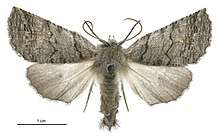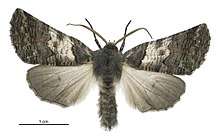Declana griseata
Declana griseata is a species of moth in the family Geometridae. It is endemic to New Zealand. This species is classified as "At Risk, Declining" by the Department of Conservation.
| Declana griseata | |
|---|---|
 | |
| Female | |
 | |
| Male | |
| Scientific classification | |
| Kingdom: | |
| Phylum: | |
| Subphylum: | |
| Class: | |
| Order: | |
| Family: | |
| Genus: | |
| Species: | D. griseata |
| Binomial name | |
| Declana griseata | |
Taxonomy
D. griseata was first described and illustrated by George Vernon Hudson in 1898.[2] Hudson further discussed and illustrated the species both in his 1928 and 1939 publications.[3][4] The lectotype specimen is held at the Museum of New Zealand Te Papa Tongarewa.[5]
Description
Hudson gave a description and illustration of the larvae of this species in his 1939 publication.[4] In appearance the larvae are extremely variable but it is able to mimic the appearance of a twig on its host plant.[4]
The pupa are enclosed in a cocoon made of moss and plant detritus and can be found on the ground.[4]
Hudson described the adult moth as follows:
The expansion of the wings of the male is 1 1⁄8 inches, of the female 1 3⁄8 inches. The fore-wings are dull slaty-grey, with a slightly paler central band; there is a fine oblique wavy transverse line at about one-fourth, another at about one-half, and indications of a third at about three-fourths ; numerous minute black streaks are thickly scattered over the wing, especially near the base and the termen ; the outline of the termen is very slightly scalloped. The hind-wings are pale grey, darker near the termen. The body is very dark slaty-grey. The antenna of the male are not bi-pectinated.[2]
Distribution
D. griseata is endemic to New Zealand.[1][6] This species range is from the Bay of Plenty/Taupo to Southland.[7] However it is likely locally extinct in some North Island localities.[7][8] D. griseata has been recorded as being collected in Wellington,[2] Top house at Lake Rotoiti,[4] Mount Hutt,[4] Castle Hill,[4] Cave Creek in Paparoa National Park,[4] Arthurs Pass,[4] Waiho Gorge in Westland,[3] Dunedin,[3] Ben Lomond,[4] Lake Wakatipu,[2] Takitimu Mountains in Southland,[4] Invercargill[3] and Orepuki.[3]
Biology and behaviour
The larvae of D. griseata are present in December and January.[4] The adult moths emerge from February.[4] This species can be found on the wing from September until May and is attracted to light.[3] Adults rest on mossy tree trunks in the vicinity of their host plants.[9]
Host species
The host species of this moth are leafy mistletoes,[7] including Peraxilla colensoi.[4]
Conservation status
This moth is classified under the New Zealand Threat Classification system as being "At Risk, Declining".[10] It was regarded by Hudson as being a scarce species even when first described.[2] The survival of this moth is dependent on the survival of its host plants.[7]
References
- "Declana griseata Hudson, 1898". www.nzor.org.nz. Landcare Research New Zealand Ltd. Retrieved 9 May 2018.
- Hudson, G. V. (1898). New Zealand moths and butterflies (Macro-lepidoptera). London: West, Newman & Co. p. 98. doi:10.5962/bhl.title.7912.
- Hudson, G. V. (1928). The Butterflies and Moths of New Zealand. Wellington: Ferguson & Osborn Ltd. p. 151.
- Hudson, George Vernon (1939). A supplement to the butterflies and moths of New Zealand. Wellington: Ferguson & Osborn. p. 416. OCLC 9742724.
- Dugdale, J. S. (1988). "Lepidoptera - annotated catalogue, and keys to family-group taxa" (PDF). Fauna of New Zealand. 14: 164. Retrieved 9 May 2018.
- Gordon, Dennis P., ed. (2010). New Zealand inventory of biodiversity. Volume two. Kingdom animalia : chaetognatha, ecdysozoa, ichnofossils. Vol. 2. Christchurch, N.Z.: Canterbury University Press. p. 459. ISBN 9781877257933. OCLC 973607714.
- Patrick, Brian; Dugdale, John S. (2000). Conservation status of the New Zealand lepidoptera (PDF). Wellington, N.Z.: Department of Conservation, New Zealand. ISBN 0478218672. OCLC 154670803.
- Keesing, Vaughan (6 May 2012). "Ecological Review of the Terrestrial Ecological AEE Prepared for the Hawke's Bay Regional Council Ruataniwha Water Storage Project" (PDF). www.hbrc.govt.nz. Retrieved 9 May 2018.
- Glime, J. M. (2017). "Terrestrial Insects: Holometabola – Lepidoptera: Geometroidea – Noctuoidea". www.digitalcommons.mtu.edu. Retrieved 9 May 2018.
- Hoare, R.J.B.; Dugdale, J.S.; Edwards, E.D.; Gibbs, G.W.; Patrick, B.H.; Hitchmough, R.A.; Rolfe, J.R. (2017). Conservation status of New Zealand butterflies and moths (Lepidoptera), 2015 (PDF). Wellington, New Zealand: New Zealand Department of Conservation. p. 7. ISBN 9781988514383.